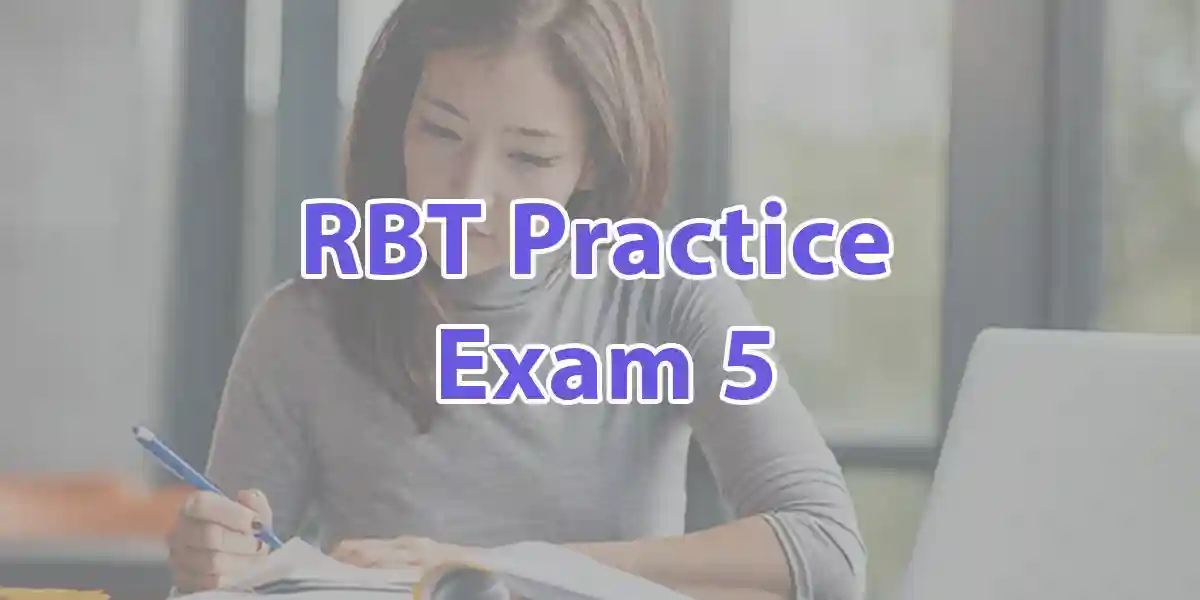If you’re looking to refine your skills and boost your confidence before taking the Registered Behavior Technician certification exam, RBT Practice Exam 5 offers another opportunity to solidify your understanding and apply your knowledge under realistic test conditions.
This practice test includes 50 thoughtfully crafted multiple-choice questions that reflect the kinds of scenarios, decisions, and concepts you’ll be expected to know as an RBT. From ethical dilemmas to data collection methods, every question is aligned with the BACB RBT Task List and intended to prepare you for the challenges of the actual exam and the responsibilities of the role itself.
Start RBT Practice Test 5 Now
Are you prepared to evaluate your preparedness more thoroughly? RBT Practice Exam 5 is your next move. Please take your time working through the questions and explanations, and use what you learn to further enhance your preparation.
You’re building more than test-taking skills; you’re preparing for a meaningful career that supports clients, families, and behavior change. Start now, and continue building the confidence you’ll carry into your exam and beyond.
Why Continue Practicing at This Stage
By this point in your journey, you’ve likely completed the core training requirements, reviewed critical ABA concepts, and spent time using mock exams to gauge your progress. Maybe you’ve already completed RBT Practice Exam 1, RBT Practice Exam 2, RBT Practice Exam 3, and RBT Practice Exam 4. Each of these tests has helped you build foundational knowledge and test your reasoning in applied settings.
So why keep going? Exam preparation involves not only acquiring knowledge but also the ability to swiftly and precisely recall, utilize, and articulate that knowledge in novel and unfamiliar situations. Practice Exam 5 pushes you further, with more nuanced questions that require profound understanding and careful reading.
What You’ll Learn From Practice Exam 5
This exam challenges your ability to interpret complex behavior scenarios, navigate ethical concerns, and distinguish between closely related ABA terms and strategies. It introduces real-world situations that mirror what behavior technicians face in homes, clinics, and schools.
The topics covered include:
- Choosing the appropriate measurement tools for different behaviors
- Understanding reinforcement contingencies and response prompts
- Identifying the function of behaviors based on observations
- Implementing behavior intervention plans ethically and effectively
- Applying skill acquisition techniques based on learner profiles
- Maintaining clear and objective documentation
A detailed explanation follows each question to help you understand the reasoning behind the correct answer. Even if you get the question right, reading the reasoning will reinforce your understanding. And if you miss it? That’s a learning opportunity—not a setback.
How to Get the Most Out of This Test
To maximize the benefit of RBT Practice Exam 5:
- Set up a quiet testing space. Approach this exam like a rehearsal. Please minimize distractions and consider scheduling yourself for an added challenge.
- Please complete all questions before reviewing any feedback. This process gives you a clearer picture of how well you can perform without external help.
- Please review each explanation carefully. Pay special attention to the terminology used in both the question and the answers. Many RBT Practice Test questions are designed to test your understanding of ABA language and its correct use.
- Make a note of tricky concepts. If a particular term or topic feels unfamiliar, go back to your training materials or flashcards for reinforcement.
What This Exam Reveals About Your Readiness
While scoring well on a practice test can boost your confidence, the real power of an exam like this lies in its feedback. Pay close attention to:
- Which content areas do you struggle with (e.g., reinforcement, behavior reduction, data collection)
- The reasoning behind incorrect answers— Was it a misread? Was there a misunderstanding of terminology? Have you recently revisited a particular concept?
- Are you overanalyzing simple questions or underestimating scenario-based ones?
The goal isn’t just to get more questions right. It’s to understand how you think, how you apply concepts, and where to focus next.
Common Pitfalls You’ll Learn to Avoid
Many candidates make the same avoidable mistakes:
- Rushing through questions and missing key words like “most appropriate” or “first step”
- Confusing similar terms, such as positive punishment vs. negative reinforcement
- Misinterpreting ethics questions by ignoring the professional scope or responsibilities defined by the BACB
- Guessing on measurement types without considering what’s being measured (frequency, duration, latency, etc.)
The structure of Practice Exam 5 helps you identify and fix these errors before they cause issues on your actual certification test.
Why Continued Practice Improves Performance
Studying theory and reviewing materials is crucial, but practice is what transforms information into confidence. Working through multiple exams allows you to:
- Get used to the format and language of real test questions
- Build test-taking endurance and focus
- Strengthen decision-making in ethically or clinically ambiguous scenarios
- Reduce anxiety through familiarity and repetition
- Improve speed and efficiency in answering multiple-choice items
The more you practice, the more automatic your recall becomes—and that’s the key to success on exam day.
Connecting Knowledge With Real-World Skills
Each question in RBT Practice Exam 5 is based on situations that reflect real-life RBT work. Whether you’re asked to respond to a behavioral crisis, make a data collection decision, or choose the right communication method for a parent, you’re being prepared for what comes after certification.
This test helps connect your academic training with professional expectations. When you can confidently answer scenario-based questions here, you’re also training yourself to respond appropriately in the field.
Review, Reflect, Refine
Once you’ve completed all 50 questions, take time to review your score, but go further—reflect on why you got certain questions wrong and how you can avoid repeating that error. Then, refine your study strategy:
- Use flashcards for any terms you missed
- Re-watch training videos on weak topic areas
- Create a quick-reference sheet for last-minute review
- Retake earlier practice exams to track improvement over time
The review loop, which includes testing, reflecting, and refining, is what solidifies learning.
You’re Closer Than You Think
Taking RBT Practice Exam 5 is more than another checkpoint—it’s a statement that you’re committed, consistent, and capable. You’ve come a long way from the early days of RBT Practice Exam 1, worked through the challenges of Practice Exams 2 and 3, and strengthened your knowledge with RBT Practice Test 5.
This new set of questions keeps the momentum going and ensures that you’re not only prepared for the test but also for the real-world demands of the role.

